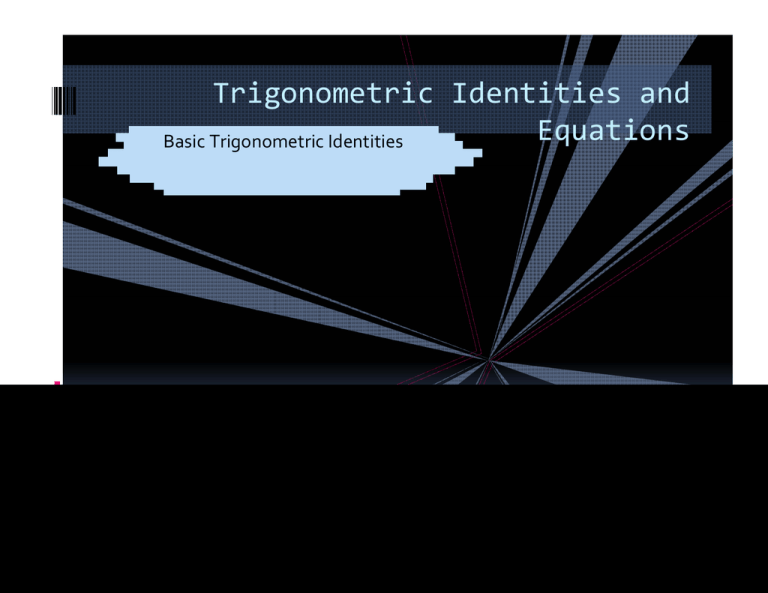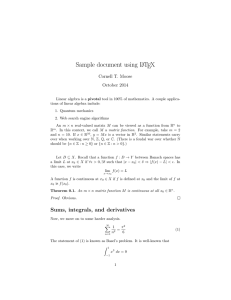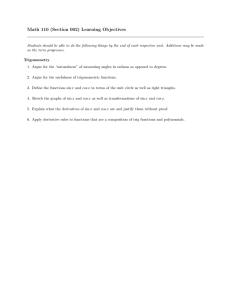Trigonometric Identities and Equations Basic Trigonometric Identities
advertisement

Trigonometric Identities and Equations Basic Trigonometric Identities Trigonometric Identity A statement of equality between two expressions that is true for all values of the variable(s) for which the expressions are defined is called an identity. An identity involving trigonometric expressions is called a trigonometric identity. Reciprocal Identities The following trigonometric identities hold for all values of θ where each expression is defined. Quotient Identities The following trigonometric identities hold for all values of θ where each expression is defined. Pythagorean Identities Example #1 Prove than sinxtanx = cosx is not a trigonometric identity by producing a counterexample. 3 3 3 3 Sign of the function To determine the sign of a function value, you need to know the quadrant in which the angle terminates. The signs of function values in different quadrants are related according to the symmetries of the unit circle. Cos ‐ Cos + Sin + Sin + Cos ‐ Cos + Sin ‐ Sin ‐ Symmetry identities We know that one revolution is 360 degrees. If the angles differ by a multiple of 360 degrees, we know that the sine and cosine will have the same value and sign. K is an integer for all the symmetry identities. Sin (A+360K)=Sin A and Cos (A+360K)=Cos A 57 degrees Sin 57 = Sin 777 Cos 57 = Cos 777 777 degrees What if the angles differ by an odd multiple of 180 degrees? Question 1: Why does it need to be an odd multiple of 180 degrees? Question 2: what quadrants do the terminal sides of the angles lie in? Question 3: How would you write the equation for angles that differ by an odd multiple of 180 degrees. What will the signs of the values look like? 180 degrees rotation Symmetry Identities Answers: If it was and even integer for K, we would have rotated to where 0 degrees is located , not 180 degrees. The terminal sides lay in diagonally opposite quadrants. The values of both sine and cosine change to the negative. Sin (A+180)(2k‐1)= ‐ sinA Cos (A+180)(2k‐1)= ‐ cosA Symmetry identities If you rotate clockwise, A and 360K‐A will lie in vertically adjacent quadrants. This will make the sine values opposite but the cosine values the same. Sin (360K‐A) = ‐ Sin A Cos (360K‐A)= Cos A If you rotate clockwise, A and 180(2k‐1)‐A, they will lie in horizontally adjacent quadrants, the sine values are the same but the cosine values are opposite. Sin (180(2k‐1)‐A)=SinA and Cos(180(2k‐1)‐A)= ‐ CosA Example #1 Example: Express Cos 750 degrees as a trigonometric function of an angle in Quadrant I. Well 2 revolutions will be 360 (2)=720 degrees, putting us back at zero degrees and we have 30 degrees more. So Cos 750=Cos 30 Example # 2 Express Cos (‐410 degrees) as a trigonometric function of an angle in Quadrant IV. Here we are going to go clockwise. We know one revolution clockwise will be ‐360 degrees and 50 degrees more clockwise will bring us to 310 degrees or Cos ‐50. If we want to show it in Quadrant I, using the opposite angle identity, we know cos (‐A)=CosA. Therefore Cos‐50=Cos 50 Opposite Angle Identities Sin (‐A)= ‐ Sin A Cos (‐A)= Cos A HW #1 Section 7‐1 Pp 427‐430 # 18‐32, 38‐41, 44‐47, 60, 66





